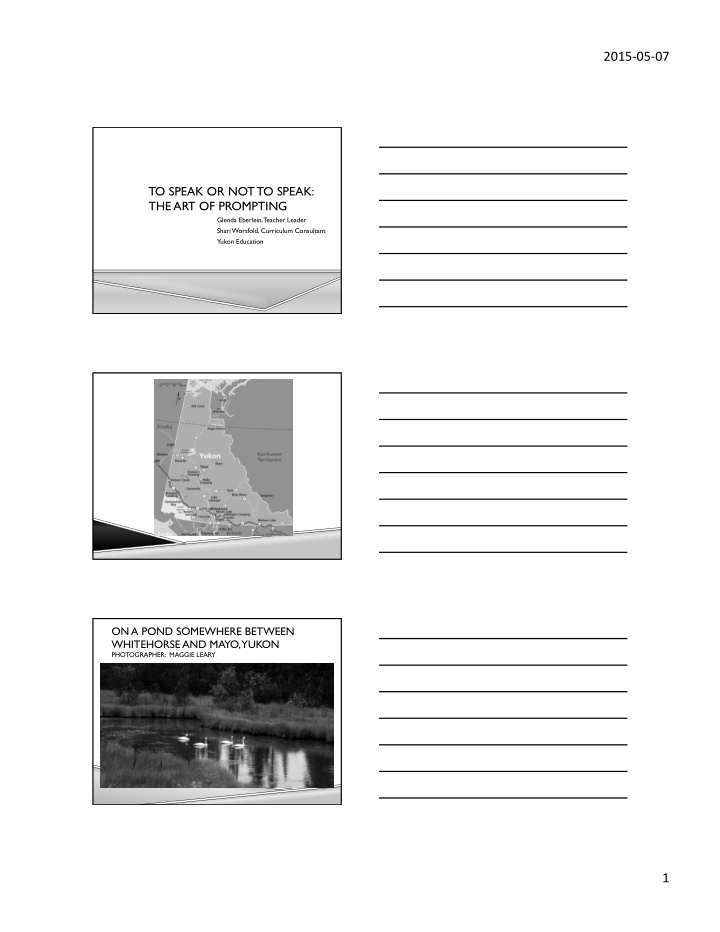



2015-‑05-‑07 ¡ TO SPEAK OR NOT TO SPEAK: THE ART OF PROMPTING Glenda Eberlein, Teacher Leader Shari Worsfold, Curriculum Consultant Yukon Education ON A POND SOMEWHERE BETWEEN WHITEHORSE AND MAYO, YUKON PHOTOGRAPHER: MAGGIE LEARY 1 ¡
2015-‑05-‑07 ¡ EMERALD LAKE NEAR CARCROSS PHOTOGRAPHER: MAGGIE LEARY DEMPSTER HWY NORTH OF DAWSON PHOTOGRAPHER: MAGGIE LEARY ICE FOG IN MAYO, YUKON (-40C) PHOTOGRAPHER: MAGGIE LEARY 2 ¡
2015-‑05-‑07 ¡ NORTHERN LIGHTS TO SPEAK OR NOT TO SPEAK: THE ART OF PROMPTING Glenda Eberlein, Teacher Leader Shari Worsfold, Curriculum Consultant Yukon Education 3 ¡
2015-‑05-‑07 ¡ “It has helped early intervention teachers to think of students as building a network or system for working on print that becomes smart enough to extend itself.” (Clay, p 103, 2005) What did Clay mean to be “smart enough to extend itself”? CONSTRUCTIVE ACTIVITY We know from Marie Clay that children construct working systems and that our job is to guide them with strategic teaching and prompts. LEARNING CYCLE 4 ¡
2015-‑05-‑07 ¡ BEGIN WITH THE END IN MIND Teachers aim to produce independent readers so that reading and writing improve whenever children read and write. The reader who problem solves independently has continual access to new learning. Some things become routine and the brain takes over most of the checking and rapidly locates familiar things. The reader is then free to deliberately attend to other things and can, independent of the teacher, extend his own learning. (Literacy Lessons, Part 1, page 40) On text of appropriate level of difficulty the child can, Monitor his own reading and writing Search for information in word and letter sequences, and in meanings, Discover new things from himself Cross check one source of information with another Repeat as if to confirm his reading and writing so far, And self correct to solve the problem LOOKING THROUGH THE LENS OF LITERACY PROCESSING WHAT STRATEGIES DOES SHE CONTROL? Monitor his own reading and writing Search for information in word and letter sequences, and in meanings, Discover new things from herself Cross-check one source of information with another Repeat as if to confirm his reading and writing so far, And self correct to solve the problem 5 ¡
2015-‑05-‑07 ¡ PROMPTING FOR CONSTRUCTIVE ACTIVITY Conversations in the lesson should be warm and friendly, but when the child must attend to something, or must pull several things together, the prompt should be short, clear and direct. Literacy Lessons, Part 2, p. 202 WHAT IS A PROMPT? Call to action Prompts are not just talk Short prompts give a maximum of information to a child using the fewest words “Too much teacher talk” interferes with solving a problem What is the next most helpful thing Samantha needs to learn? OBSERVE TEACHER What do I say and do? 6 ¡
2015-‑05-‑07 ¡ OBSERVE CHILD What does Samantha say and do? What was the part of a processing system that Samantha learned more about? LEVELS OF SUPPORT Most Teacher Help Less teacher help and more child work Least teacher help Literacy Lessons, Part 2, p. 94 PROCESS OF BECOMING KNOWN It usually takes several encounters to learn something new. We can think of a new response coming into a child’s repertoire of literacy behaviours as being: New Only just known Successfully problem-solved Easily produced but easily thrown Well-known and recognized in most contexts Known in many variant forms. Literacy Lessons, Part 2, p. 46 7 ¡
2015-‑05-‑07 ¡ The child is extending his own literacy learning and is building his own neural networks to support continuing progress. Literacy Lessons, Part 1, p. 41 FOUNDATIONS FOR A SELF-EXTENDING SYSTEM q Give the child ways to detect errors for herself q Encourage attempts to correct error q Give her clues to aid self correction q Allow her to make checks or repetitions to confirm her first attempts q When she works out a word or text for herself, ask her “how did you know?” Do not overdo this !! FOSTERING THE DEVELOPMENT OF INDEPENDENT PROBLEM SOLVING q Prompting constructive activity q Working with new knowledge q Accepting the child’s initiatives q Accepting partially correct responses q Playing with anticipation q Developing attention to features q Asking the child ‘to learn’ q Praising the way a child worked towards the solution, whether it was reached or not q Lifting the difficulty level q Revisiting the familiar 8 ¡
2015-‑05-‑07 ¡ Encouraging the beginnings of a self-extending system early. The child is learning how to read because of the effective processing he does when he reads . Using what he can do well makes a good system stronger. Contrast this with forcing a child to use a confused processing system without offering help. That can only create further confusion. Literacy Lessons, Part 1, p.41 LEARNING CYCLE A SELF-EXTENDING SYSTEM UNDER CONSTRUCTION 9 ¡
Recommend
More recommend